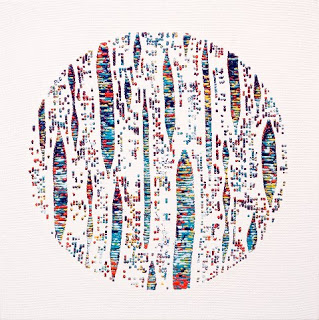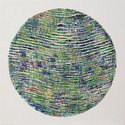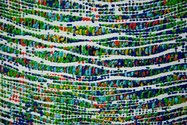John Hurrell – 31 May, 2009
Without any understanding of colour Larkin's method of pushing paint through the weave of the canvas from behind becomes a shallow gimmick. The method doesn't develop an aesthetic for the artefact by indicating chromatic control nor does it show a sensitive relationship with the dominant ‘neutral' colour that happens to be white.
With this exhibition Peata Larkin has abandoned the rectangular format that was evident on the works she included in an earlier Two Rooms group show. The new circular or eliptical ‘paintings’, set within square canvases, suffer greatly because of this. In my view her work is going backwards.
The reasons in essence are formal: too many colours to provide a sense of structured meaning; the myriad colours included don’t have nuanced relationships and in fact clash for complementary (optical) reasons; and the beaded globules of paint are usually too small to have impact in relation to the size of the stretcher.
Without any understanding of colour Larkin’s method of pushing paint through the weave of the canvas from behind becomes a shallow gimmick. The method doesn’t develop an aesthetic for the artefact by indicating chromatic control nor does it show a sensitive relationship with the dominant ‘neutral’ colour that happens to be white.
If there are meanings in these works (as claimed in the gallery blurb), then I don’t see them. However as a pakeha male it might reasonably be argued that I lack the appropriate biological, contextual and cultural background to have access to those aspects. If that is true and I am uninformed, then I hope some readers will present a clear counter-position, possibly along the lines that (as the gallery notes say) ‘in Maori tradition the weaver is the storyteller’ and that in these works there are stories of value. It would be good to hear other opinions.
John Hurrell




 Advertising in this column
Advertising in this column Two Rooms presents a program of residencies and projects
Two Rooms presents a program of residencies and projects



This Discussion has 0 comments.
Comment
Participate
Register to Participate.
Sign in
Sign in to an existing account.